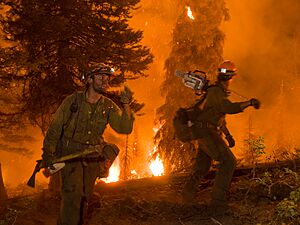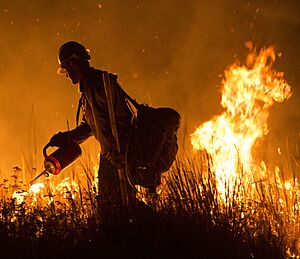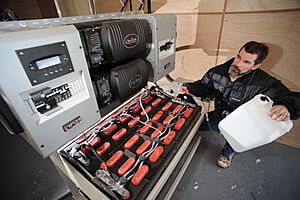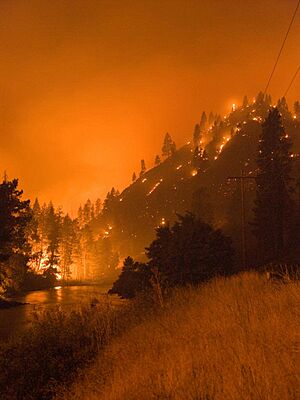Climate change in Idaho facts for kids
Just like other places on Earth, Idaho's climate has changed a lot over a very long time. Scientists use old records to learn about these past changes. We also have weather records from the late 1800s that show us what's been happening more recently. Today, many people are worried about how human activities are changing the climate. Things like burning fossil fuels (which releases carbon dioxide) and farming (which releases methane) are big concerns. Because of this, universities, state groups, and federal agencies in Idaho are all working hard to understand what these climate changes mean for our state.
Idaho actually produces the least amount of carbon dioxide per person in the United States. We release less than 23,000 pounds a year. This is because Idaho mostly uses clean hydroelectric power from its many rivers.
However, Idaho has still seen temperatures go up, especially in the last few decades. From 1971 to 2005, the average yearly temperature in southern Idaho's Snake River Plain increased by 1.4 degrees Celsius (about 2.5 degrees Fahrenheit). This warming was most noticeable in January, March, and April. While rainfall has generally increased since the early 1900s, it changes so much that it's hard to see a clear trend.
Looking ahead to the next 100 years, Idaho's climate is expected to change even more. This is due to natural weather patterns and also because of how rising greenhouse gases affect the climate. For example, experts predict that by 2100, winter and summer temperatures in Idaho could rise by about 5 degrees Fahrenheit. Spring and fall temperatures might increase by about 4 degrees Fahrenheit. Winter precipitation could go up by 20%, and spring and fall by 10%. Summer rainfall is expected to stay about the same. We might see more very wet or snowy days in winter. Also, very hot days in summer would become more common. It's not clear how bad storms might get, but stronger winter storms are possible.
Contents
How Climate Change Affects Idaho
Water Resources
Idaho gets most of its water from rivers and streams, but underground water is also important. Most of Idaho's water flows into the Columbia River. This includes rivers like the Spokane, Pend Oreille, Kootenai, and Snake rivers. Dams and reservoirs on these rivers help control spring floods and keep water flowing in summer.
The amount of water in Idaho's rivers depends a lot on how much snow falls in winter and how fast it melts in spring. A warmer climate could mean less snow and more rain in winter. It could also cause snow to melt faster and earlier. This might lead to lower water levels in reservoirs and less water available in summer and fall. Also, hotter summer temperatures and more evaporation would mean less water in rivers and lakes. Drier summers would make it harder to share water among all the different users in Idaho.
Agriculture
As the climate gets warmer, farming areas might shift northward. Unpredictable weather could make it harder for farmers to adapt. Warmer temperatures and drier soil (because of more evaporation) might mean farmers need to water their crops more. However, these same conditions could also mean there's less water available for irrigation.
Farming is a huge business in Idaho, bringing in $2.8 billion each year. About 60% of this comes from crops. Nearly 70% of Idaho's farmland uses irrigation. The main crops grown here are wheat, hay, barley, and potatoes. Climate change could increase wheat yields by 9-18%. Barley and hay yields might also go up by 12%. However, potato yields could drop by 18% if temperatures get too high for the plants. The total amount of farmed land could change by 10%, depending on how the climate changes.
Forests
Hotter and drier weather could lead to more frequent and intense wildfires. This threatens homes and forests. Drier conditions would also harm lodgepole and Douglas-fir forests, making them more likely to catch fire.
Some areas that are currently forests might turn into grasslands or rangeland. This could happen along the eastern side of the Rocky Mountains and in some western valleys. These changes would greatly affect Idaho's forests and all the activities that depend on them.
Ecosystems
Idaho has a wide variety of plants and animals. Climate change could make many existing problems for Idaho's natural areas even worse. While wildfires are a natural part of western forests, changes in how often and how intensely fires happen due to climate change are a big concern.
High mountain areas are especially at risk from climate change. They could shrink significantly. Some alpine species, like arctic gentian, alpine chaenactis, rosy finch, and water pipit, have already disappeared from some areas. This is due to losing their homes and their habitats becoming broken up. Climate change could make this worse. Whitebark pine forests might be replaced by Douglas fir. On lower mountain slopes, forests could turn into treeless areas with plants like sagebrush, Idaho fescue, and bluebunch wheatgrass.
What Idaho is Doing About Climate Change
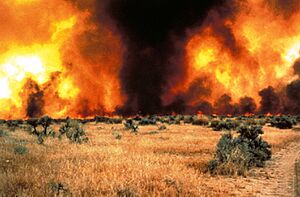
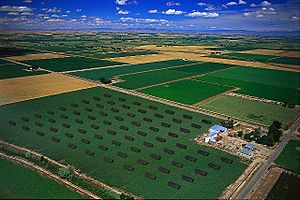
Idaho is home to groups like the Yellowstone-Teton Clean Energy Coalition and the Treasure Valley Clean Cities Coalition. These groups work on clean energy solutions.
Clean Energy and Vehicles
Cleaner Fuels for Vehicles
Idaho has a tax on motor fuels like gasoline. However, vehicles that use cleaner fuels, such as compressed natural gas, liquefied natural gas, liquefied petroleum gas, or hydrogen, might not have to pay this tax if they have a special permit. Instead, they might pay a yearly fee based on the vehicle's weight. This encourages people to use fuels that produce less pollution.
Reducing Fuel Use by State Agencies
All state government agencies in Idaho must try to use less petroleum (gasoline and diesel) in their vehicles. They do this by buying cars that get better gas mileage and by having employees drive fewer miles. Agencies are also told to choose hybrid electric vehicles and other cars that are fuel-efficient and produce less pollution.


